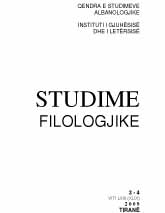Kod i ri për shenjën e vjetër në romanin “Dranja” të Martin Camajt
The new codification of the sign (symbol) in the novel “Dranja” of Martin Camaj
Author(s): Shaban SinaniSubject(s): Language and Literature Studies
Published by: Qendra e Studimeve Albanologjike
Keywords: Albania ; Albanian Philology ; Dranja; Martin Camaj
Summary/Abstract: M. Camaj wrote the novel “Dranja” at the end of the 1980s, at the time of his highest literary skill. In this work he generalized his experience in creative prose and in poetry. He called his book “madrigal”, a term borrowed from music; and scholars called it “palimpsest”, a term borrowed from medieval church paintings. “Dranja” is a search of the roots of the ancients, according to the author's own expression. The place of action (topos) is not homeland, but the land, place of birth of the writer, a very narrow space used to avoid carrying all the historical fate of the sign created by the author, the turtle named Dranja. On the contrary, time (hronos) is without limit, since the beginning of the world until the age of archaeological museums and Jurasic Park. This vertical timing on a local narrow point makes the work action more intense. It seems like in each spin of history man approaches the divine as in the motive of the biblical tower of Babel, but at the same time gets away from the possibility of understanding themselves. Different degrees of the development of the living world and human mentality appear one after another, from the dinosaurs era to the actual man of the metropolis. This creates difficulties in obtaining aesthetic of work. But this difficulty is not related to any tendency of the author to close hermetically the meaning of the work. On the contrary, differently from modernist writers, who in principle have been trying to dismantle the myths of the past, decrypt and decode secret and ancient rituals and myths, M. Camaj not only preserves the confidentiality of these myths, but in a creative way rebuilds their meaning, following the spirit of tradition. In his work “Dranja” he creates a parallel between the turtle’s fate and the people’s of his land fate. In the ethnological tradition the totem of Albanians and especially northern Albanians is the snake. But the writer does not follow formally this totem, but he transfers its functions as the protector of the tribe, the home, the fate of individuals and the fate of families to a totem artistically created and codified in the style of ethnographic literature: the turtle. The writer makes the deportation based on some hereditary links. Serpent in the oral tradition is the son-serpent, who is married to the daughter of the king (not as the heir of the crown, but as a sign of the ideal of beauty).
Journal: Studime Filologjike
- Issue Year: 2009
- Issue No: 03-04
- Page Range: 053-070
- Page Count: 18
- Language: Albanian
- Content File-PDF

